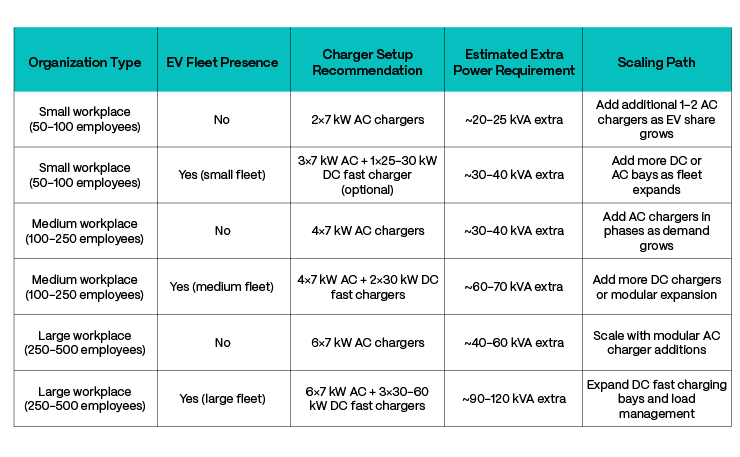How to set up EV Charging infrastructure in Corporate Spaces

Across India, ESG reporting has shifted from a “good-to-have” to a “must-have”. Companies are seeking credible, quantifiable ways to act, not just promises, because their business prospects are directly tied to this, not just goodwill.
And this is being taken very seriously. Here’s the case of Infosys. During the period 2020-2024, Infosys cut their energy consumption per million-dollar revenue by over 47% by adopting clean energy sustainability initiatives. This was coupled with the release of its detailed ESG reports, which were aligned with global frameworks like GRI and SASB. And guess what? The stock prices actually went up and were followed by higher investor inflows.
Installing EV chargers in corporate spaces is one of the most impactful, measurable sustainability initiatives. It has clear Scope 3 benefits: lowering carbon emissions from employee commutes and company fleets, reducing diesel reliance, and aligning with national clean mobility goals. And it is an initiative that becomes an additional revenue prospect for businesses, given that it is emerging as a core utility.
India’s corporate workers are leading the charge in EV adoption
Corporate employees, fleet operators, and commercial vehicle owners form the backbone of India’s early EV adoption, especially in metros such as Bengaluru, Pune, and Delhi. Around 55-60% of EVs in India are registered in cities.
Government programs like FAME and PM E-DRIVE have accelerated this shift by creating the foundation for integrating EV charging infrastructure. Several states now mandate or incentivise EV-ready provisions in commercial buildings, ensuring that future projects are built with electrification in mind.
EV charging is becoming important in corporate spaces
As EVs become mainstream, workplaces are naturally evolving into key charging hubs. Vehicles parked for several hours enable both opportunistic and scheduled charging.
Offices that provide on-site EV chargers can promote sustainable commuting, reducing dependence on diesel generators during peak hours. They can directly boost their ESG credentials as EV charging reduces their Scope 3 emissions. They also improve employee satisfaction, and benefit from tariff incentives or government support.
For developers, it increases property appeal and earns credits under green certification programs such as LEED, IGBC, and GRIHA.
For offices wanting to integrate EV charging in their space, three planning priorities are key:
- Engage utilities early to secure sufficient power capacity and avoid grid constraints.
- Design a modular infrastructure that supports phased charger installation as demand grows.
- Include 2W and 3W charging bays to cater to delivery fleets and employee scooters, reflecting India’s diverse mobility needs.
Many utilities also provide rebates that help offset installation costs, creating a strong financial and environmental business case for deployment. Before launching EV initiatives, companies should coordinate with legal and finance teams to ensure compliance and cost efficiency
Together, these measures build scalable, future-ready workplace EV charging ecosystems. Once these things are taken care of, one comes to the actual process of integrating EV charging.
Here are a few things to keep in mind while doing it.
5 key considerations for integrating EV charging in a corporate space
Every workplace differs in design, size, and user type. Effective EV infrastructure planning must consider these variations:
Commercial Property Developers and Business Parks
Large business parks should establish shared charging bays accessible to multiple tenants. Centralised Dynamic Load Management (DLM) systems distribute power evenly and prevent overloads as the number of chargers increases. Using OCPP-compatible hardware allows integration with building management systems for energy monitoring. Pre-installed conduits, reserved breaker space, and centralized metering simplify future expansion and reduce retrofit costs. For Indian projects, tenders should comply with state norms and include provisions for two- and three-wheelers, as applicable.
Standalone Offices and Corporate Campuses
Dedicated parking bays for employees and visitors, managed via RFID or app-based access, make daily charging seamless. Implementing per-bay metering supports accurate cost recovery and transparent reimbursement. Designing with extra electrical capacity and modular chargers ensures readiness for the rise in EV adoption in the coming years.
1.Site
Selecting the right EV charger location is key for efficiency and user convenience. Chargers should be close to distribution panels to reduce cable runs, with well-lit, clearly marked bays. For sites with unstable power, couple EV chargers with solar-compatible battery energy storage systems, so that reliability is ensured (solar integration is even more carbon neutral than using generators). Coastal or humid locations require corrosion-resistant, marine-grade equipment for long-term durability and low maintenance. Ensure that the plumbing systems are insulated and away from the new electrical conduits.
2.Power Source
Evaluate the site’s sanctioned load and transformer capacity before installation.
- Single-phase (210–240 V) systems are ideal for AC chargers (7.4–22 kW).
- Three-phase (410–440 V) setups accommodate faster AC or clustered chargers for higher usage demands.
Planning for future scalability, such as reserving transformer space, saves significant rework costs down the line.
3.Permits
Engage early with local utilities and building authorities to streamline approvals. Permitting timelines and equipment clearances vary by state, and many regions offer capital subsidies or rebate programs that can significantly reduce setup costs. Having legal and finance teams align on available incentives helps ensure full compliance and financial efficiency. Key focus areas include:
- State mandates and subsidies: Review building codes for EV infrastructure requirements and available capital grants.
- Utility tariffs and demand charges: Optimize through time-of-use models to manage charging costs effectively.
- Co-funding and partnerships: Explore DISCOM and government support for pilot projects to lower investment barriers.
4.EV Charger
Choosing the right mix of EV chargers balances user needs, operational efficiency, and scalability. Key factors to consider include:
4.1. Charger Mix: AC and DC
- AC chargers (7.4–22 kW) are ideal for employees and visitors who need to charge for more extended periods.
- DC fast chargers (30–60 kW) suit fleet vehicles or quick-turn bays.
- This combination supports both daily charging and fast use cases.
4.2. Smart Connectivity & Management
- App-based control, authentication, analytics, and remote monitoring reduce operational overheads.
- Features such as OCPP compatibility, remote firmware updates, and telemetry enable predictive maintenance and performance monitoring.
- Secure user access via RFID or app tokens, along with session-level metering, ensures fair usage and accurate reimbursement.
- Energy analytics support demand response or time-of-use optimisation where tariffs allow, creating a cost-effective charging ecosystem.
4.3. Load Management & Scalability
- Dynamic Load Management (DLM) prevents transformer overloads by intelligently allocating available power across active chargers.
- Modular designs allow staged growth to handle increasing energy demand.
- Larger campuses can benefit from a central DLM controller with local agent software for prioritisation during peak hours, including fleet support.
4.4. Safety & Certification
- Use certified hardware (BIS, CE) with IP65+ protection for outdoor installations.
- Follow the manufacturer's thermal derating guidelines and include overcurrent and earth-fault protection.
- Proper safety measures minimise risks and ensure reliable operation under high load conditions.
4.5. Billing & Integration
- Multi-user metering, RFID access, or ID-based billing simplifies accounting.
- Options include per-bay chargebacks, centralised billing via building management systems, or voucher/reimbursement systems integrated with payroll.
- These ensure fair usage, accurate cost allocation, and minimal administrative overhead for occasional or regular users.
4.6. Design & Aesthetics
- Chargers should have a compact footprint, corporate-grade design, clear signage, and minimal visible cabling.
- Consider wall-mounted or pedestal installations, landscaping, or protective bollards where needed.
- Thoughtful design improves safety, enhances the user experience, and seamlessly integrates chargers into the corporate environment.
5.Cost Structure / Revenue Models
Corporate EV deployments can follow different financial models:
- Purchase and operate,
- CAPEX with internal cost recovery,
- shared-cost models with tenants,
- OPEX/leasing through charge point operators.
Leverage incentive programs to reduce capital costs and explore demand-charge mitigation strategies to optimize energy expenses. A well-planned financial model ensures sustainability, efficiency, and potential cost savings or revenue generation.
Here’s a quick one glance view for different organizational scenarios:

A properly configured charging setup, thoughtfully designed and well-managed, integrates seamlessly and ensures safe, scalable operations. It boosts the company’s ESG credentials and improves employee experience.
Explore our EV charging solutions here.
Frequently Asked Questions
Lorem ipsum dolor sit amet, consectetur adipiscing elit, sed do eiusmod tempor incididunt ut labore et dolore magna aliqua. Ut enim ad minim veniam, quis nostrud exercitation ullamco laboris nisi ut aliquip ex ea commodo consequat. Duis aute irure dolor in reprehenderit in voluptate velit esse.
Lorem ipsum dolor sit amet, consectetur adipiscing elit, sed do eiusmod tempor incididunt ut labore et dolore magna aliqua. Ut enim ad minim veniam, quis nostrud exercitation ullamco laboris nisi ut aliquip ex ea commodo consequat. Duis aute irure dolor in reprehenderit in voluptate velit esse.
Lorem ipsum dolor sit amet, consectetur adipiscing elit, sed do eiusmod tempor incididunt ut labore et dolore magna aliqua. Ut enim ad minim veniam, quis nostrud exercitation ullamco laboris nisi ut aliquip ex ea commodo consequat. Duis aute irure dolor in reprehenderit in voluptate velit esse.
Lorem ipsum dolor sit amet, consectetur adipiscing elit, sed do eiusmod tempor incididunt ut labore et dolore magna aliqua. Ut enim ad minim veniam, quis nostrud exercitation ullamco laboris nisi ut aliquip ex ea commodo consequat. Duis aute irure dolor in reprehenderit in voluptate velit esse.
Lorem ipsum dolor sit amet, consectetur adipiscing elit, sed do eiusmod tempor incididunt ut labore et dolore magna aliqua. Ut enim ad minim veniam, quis nostrud exercitation ullamco laboris nisi ut aliquip ex ea commodo consequat. Duis aute irure dolor in reprehenderit in voluptate velit esse.



